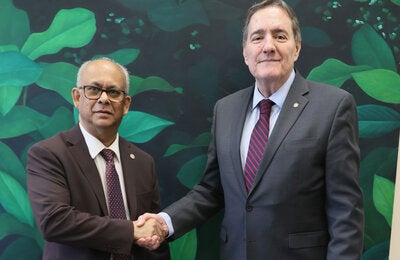Washington, D.C., 29 September 2016 (PAHO/WHO)- Health authorities from the Americas endorsed a new strategy to control arboviruses, a group of mosquito-transmitted viruses that includes Zika virus as well as dengue, chikungunya, and yellow fever, at the 55th Directing Council of the Pan American Health Organization (PAHO).
"Arboviral diseases are a recurring public health problem in the Americas, causing significant human suffering and contributing to the cycle of poverty," said Sylvain Aldighieri, Deputy Director a.i. for Health Emergencies. "We have been fighting these diseases for years, but separately. This new strategy sets out clear actions that are needed to address multiple arboviral diseases in an integrated way."
In presenting the new strategy to the 55th PAHO Directing Council this week, Aldighieri cited data showing that dengue continues to be a serious health problem in the Western Hemisphere and was responsible for some 14.2 million cases and 7,000 deaths between 2000 and 2014. Chikungunya, which emerged in the Americas in late 2013, has affected over 1.7 million in the region. Zika virus, reported in Brazil in 2015, has now affected 47 countries and territories in the region, often with serious health consequences.
Many of the measures contained in the strategy are based on proven methods for controlling dengue, which is carried by the same mosquito, Aedes aegypti, as Zika and chikungunya. The strategy also calls for strengthening the Arbovirus Diagnosis Laboratory Network of the Americas.Because few vaccines are currently available to prevent the arboviral diseases of public health importance, the new strategy recommends prevention and control efforts focused on reducing mosquito populations, ensuring timely and accurate clinical diagnosis, and strengthening epidemiological integrated surveillance and networks of laboratories. Actively involving communities in eliminating mosquito breeding sites is central to controlling mosquitoes, and the strategy calls for special efforts to protect pregnant women in the context of the Zika outbreak. It also calls for improving clinical management of patients with arboviral disease.
In addition, the strategy acknowledges the need for innovation to more successfully fight these diseases. PAHO/WHO is already helping countries to expand pilot studies using new tools for vector control such as the use of mosquitoes infected by the Wolbachia bacteria and genetically modified mosquitoes.
In approving the new strategy, delegates to the 55th PAHO Directing Council pledged to mobilize the necessary support and resources to implement the strategy at the national level.
Update on Zika
In a separate report on Zika, Aldighieri told health ministers that PAHO mounted a strong response when the Zika virus outbreak was first identified in the Americas, but more evidence is needed for an accurate assessment of the future health repercussions of this virus. Scientists don't yet know enough about Zika or Zika Congenital Syndrome to measure its possible impact on public health, so the long-term outlook in Latin America and the Caribbean is still uncertain, he said.
PAHO mounted more than 65 missions to 29 countries where Zika virus was identified, sending over 100 experts to help countries in numerous areas. These include antenatal care, clinical management, entomology and vector control, epidemiology, health and laboratory services, neonatology, neurology, public health, radiology services, risk communication, and related areas.
"While the introduction of Zika Virus in the Region is enabling a better understanding of the full spectrum of disease caused by this virus, over 500 million people in the Region are living in areas at risk for transmission of the virus, and its spread could pose a significant burden to public health and to health systems as a whole," PAHO's report noted.
The Directing Council of PAHO brings the Ministers of Health and high-level delegates of the PAHO/WHO member countries together in Washington, D.C. to discuss and analyze health policies, set priorities for PAHO's technical cooperation programs, and foster collaboration on public health at the regional level.



